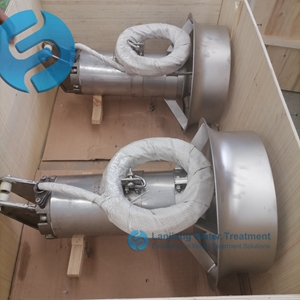The principle of sewage mixer

The principle of the sewage mixer is mainly to rotate the stirring shaft and impeller through the motor, and generate thrust, shear force and turbulence in the sewage using the principle of fluid mechanics, so as to achieve the full mixing and uniform distribution of sewage. Specifically, the mixer agitates the liquid through a rotating impeller, creating a spiral jet and an axial push flow. The rotational jet is mixed by the shear force along the jet surface, and the liquid other than the fluid is stirred by friction. Axial push flow uses axial thrust to move the controlled fluid forward. The volume flow is formed under the joint action of the rotary jet and the axial push flow, and the necessary water velocity and process flow field are obtained by applying the large volume flow mode to meet the various process requirements in the wastewater treatment process.
Principles of sewage treatment
Sewage treatment is a complex process, involving physical, chemical and biological methods, the purpose is to separate or transform the pollutants in domestic or industrial wastewater, so that the wastewater can meet the standards of discharge or reuse. The following are the main principles of sewage treatment:
Physical processing principle:
Physical treatment refers to the use of physical action to separate suspended solids and impurities in wastewater. Common physical treatment methods include precipitation, filtration, centrifugal separation, clarification and so on. These methods are mainly through the physical forces such as gravity and centrifugal force, so that the suspended matter and impurities in the wastewater gradually settle or separate, so as to achieve the purpose of purification.
Chemical treatment principle:
Chemical treatment refers to the use of chemical reactions to transform or precipitate dissolved substances and complexes in wastewater. Common chemical treatment methods include neutralization, precipitation, REDOX, adsorption, etc. These methods achieve the purpose of purification by adding chemical agents to react with harmful substances in wastewater and convert them into harmless or low-harm substances.
Biological treatment principle:
Biological treatment refers to the use of microbial metabolism to decompose organic matter in wastewater into inorganic matter, so as to achieve the purpose of purification. Biological treatment methods include activated sludge method, biofilm method, anaerobic biological treatment and so on. These methods cultivate and domesticate specific microorganisms, multiply them in large numbers under suitable environmental conditions, and then use their metabolic action to degrade organic matter and purify wastewater.
Sewage treatment process flow
The wastewater treatment process usually includes pre-treatment stage, primary treatment stage, activated sludge treatment stage and advanced treatment stage. Each stage is targeted at different pollutants and targets, and through the combination of physical, chemical and biological methods, the wastewater can finally meet the discharge standards or meet the requirements of reuse.
To sum up, the sewage mixer and sewage treatment is an indispensable part of the sewage treatment system, they work together through different principles and methods, to achieve the purification of sewage treatment.
Nanjing LanJiang Water Treatment Equipment Co.,Ltd manufactures equipment for wastewater treatment. We were established in 2001. Since then, we designed and produced submersible mixers, top entry mixers, aerators and other wastewater treatment equipment.
Post time:2024-08-14